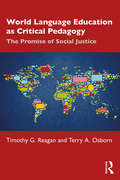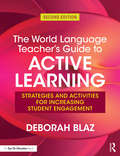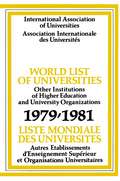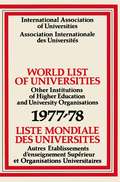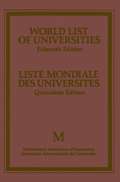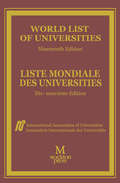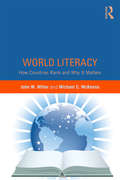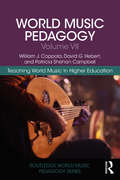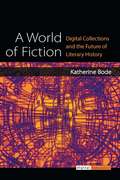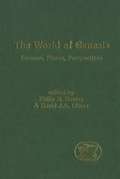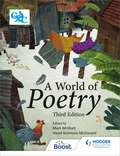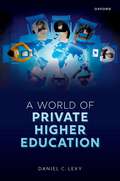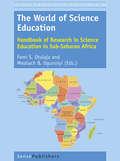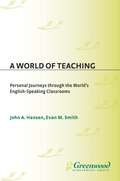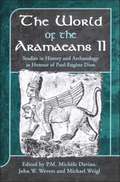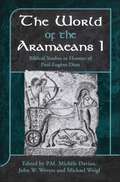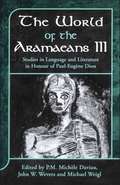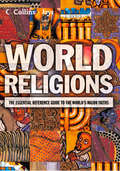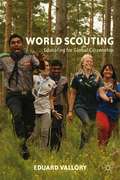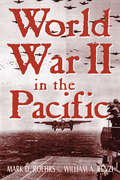- Table View
- List View
World Language Education as Critical Pedagogy: The Promise of Social Justice
by Timothy G. Reagan Terry A. OsbornAccessible and cutting-edge, this text is a pivotal update to the field and offers a much-needed critical perspective on world language education. Building off their classic 2002 book, The Foreign Language Educator in Society, Timothy G. Reagan and Terry A. Osborn address major issues facing the world language educator today, including language myths, advocacy, the perceived and real benefits of language learning, linguistic human rights, constructivism, learning theories, language standards, monolingualism, bilingualism and multiculturalism. Organized into three parts – "Knowing Language," "Learning Language," and "Teaching Language" – this book applies a critical take on conventional wisdom on language education, evaluates social and political realities, assumptions, and controversies in the field. Each chapter includes questions for reflection and discussion to support students and educators in developing their own perspectives on teaching and learning languages. With a critical pedagogy and social justice lens, this book is ideal for scholars and students in foreign/world language education, social justice education, and language teaching methodology courses, as well as pre- and in-service teachers.
The World Language Teacher's Guide to Active Learning: Strategies and Activities for Increasing Student Engagement
by Deborah BlazEnhance your students’ success and improve the likelihood of retention with the easy-to-implement activities and strategies in this book! Bestselling author Deborah Blaz shows how to create a classroom in which students can actively experience, experiment with and discover a world language. The new edition features updated strategies based on brain-based research and new ideas for using technology and personalized learning. In addition, the book has been reorganized to help you easily find and pull activities you want to use in your classroom the very next day. You’ll learn how to… mix up your repertoire of activities, games, and exercises to keep students engaged; introduce students to the culture of the language you teach by hosting parties and celebrations; overcome some of the biggest obstacles in the path to fluency, including verb conjugation, using object pronouns, and the subjunctive mood; customize your teaching strategies to accommodate a broader range of talents, skills, and intelligences; implement new assessment strategies to improve verbal skills and reading comprehension; and more! Bonus: Downloadable versions of some of the resources in this book are available on the Routledge website at www.routledge.com/9781138049574, so you can print and distribute them for immediate classroom use.
The World Language Teacher's Guide to Active Learning: Strategies and Activities for Increasing Student Engagement
by Deborah BlazEnhance your students’ success and improve the likelihood of retention with the easy-to-implement activities and strategies in this book! Bestselling author Deborah Blaz shows how to create a classroom in which students can actively experience, experiment with and discover a world language. The new edition features updated strategies based on brain-based research and new ideas for using technology and personalized learning. In addition, the book has been reorganized to help you easily find and pull activities you want to use in your classroom the very next day. You’ll learn how to… mix up your repertoire of activities, games, and exercises to keep students engaged; introduce students to the culture of the language you teach by hosting parties and celebrations; overcome some of the biggest obstacles in the path to fluency, including verb conjugation, using object pronouns, and the subjunctive mood; customize your teaching strategies to accommodate a broader range of talents, skills, and intelligences; implement new assessment strategies to improve verbal skills and reading comprehension; and more! Bonus: Downloadable versions of some of the resources in this book are available on the Routledge website at www.routledge.com/9781138049574, so you can print and distribute them for immediate classroom use.
World List of Universities 1977–78 / Liste Mondiale des Universites
by International Association of UniversitiesWorld List of Universities / Liste Mondiale des Universites
by International Association of UniversitiesWorld List of Universities / Liste Mondiale des Universites
by International Association of UniversitiesA reference work for all those concerned with the administration of higher education, this volume contains information on universities and other tertiary institutions worldwide.
World Literacy: How Countries Rank and Why It Matters
by Michael C. McKenna John W. MillerInternational literacy assessments have provided ample data for ranking nations, charting growth, and casting blame. Summarizing the findings of these assessments, which afford a useful vantage from which to view world literacy as it evolves, this book examines literate behavior worldwide, in terms of both the ability of populations from a wide variety of nations to read and the practice of literate behavior in those nations. Drawing on The World’s Most Literate Nations, author Jack Miller’s internationally released study, emerging trends in world literacy and their relationships to political, economic, and social factors are explored. Literacy, and in particular the practice of literate behaviors, is used as a lens through which to view countries’ economic development, gender equality, resource utilization, and ethnic discrimination. Above all, this book is about trajectories. It begins with historical contexts, described in terms of support for literate cultures. Based on a variety of data sources, these trends are traced to the present and then projected ahead. The literate futures of nations are discussed and how these relate to their economic and sociocultural development. This book is unique in providing a broader perspective on an intractable problem, a vantage point that offers useful insights to inform policy, and in bringing together an array of relevant data sources not typically associated with literacy status.
World Literacy: How Countries Rank and Why It Matters
by Michael C. McKenna John W. MillerInternational literacy assessments have provided ample data for ranking nations, charting growth, and casting blame. Summarizing the findings of these assessments, which afford a useful vantage from which to view world literacy as it evolves, this book examines literate behavior worldwide, in terms of both the ability of populations from a wide variety of nations to read and the practice of literate behavior in those nations. Drawing on The World’s Most Literate Nations, author Jack Miller’s internationally released study, emerging trends in world literacy and their relationships to political, economic, and social factors are explored. Literacy, and in particular the practice of literate behaviors, is used as a lens through which to view countries’ economic development, gender equality, resource utilization, and ethnic discrimination. Above all, this book is about trajectories. It begins with historical contexts, described in terms of support for literate cultures. Based on a variety of data sources, these trends are traced to the present and then projected ahead. The literate futures of nations are discussed and how these relate to their economic and sociocultural development. This book is unique in providing a broader perspective on an intractable problem, a vantage point that offers useful insights to inform policy, and in bringing together an array of relevant data sources not typically associated with literacy status.
World Music Pedagogy, Volume VII: Teaching World Music in Higher Education (Routledge World Music Pedagogy Series)
by William J. Coppola David G. Hebert Patricia Shehan CampbellWorld Music Pedagogy, Volume VII: Teaching World Music in Higher Education addresses a pedagogical pathway of varied strategies for teaching world music in higher education, offering concrete means for diversifying undergraduate studies through world music culture courses. While the first six volumes in this series have detailed theoretical and applied principles of World Music Pedagogy within K-12 public schools and broader communities, this seventh volume is chiefly concerned with infusing culture-rich musical experiences through world music courses at the tertiary level, presenting a compelling argument for the growing need for such perspectives and approaches.These chapters include discussions of the logical trajectories of the framework into world music courses, through which the authors seek to challenge the status quo of lecture-only academic courses in some college and university music programs. Unique to this series, each of these chapters illustrates practical procedures for incorporating the WMP framework into sample classes. However, this volume (like the rest of the series) is not a prescriptive "recipe book" of lesson plans. Rather, it seeks to enrich the conversation surrounding cultural diversity in music through philosophically-rooted, social justice-conscious, and practice-oriented perspectives.
World Music Pedagogy, Volume VII: Teaching World Music in Higher Education (Routledge World Music Pedagogy Series)
by William J. Coppola David G. Hebert Patricia Shehan CampbellWorld Music Pedagogy, Volume VII: Teaching World Music in Higher Education addresses a pedagogical pathway of varied strategies for teaching world music in higher education, offering concrete means for diversifying undergraduate studies through world music culture courses. While the first six volumes in this series have detailed theoretical and applied principles of World Music Pedagogy within K-12 public schools and broader communities, this seventh volume is chiefly concerned with infusing culture-rich musical experiences through world music courses at the tertiary level, presenting a compelling argument for the growing need for such perspectives and approaches.These chapters include discussions of the logical trajectories of the framework into world music courses, through which the authors seek to challenge the status quo of lecture-only academic courses in some college and university music programs. Unique to this series, each of these chapters illustrates practical procedures for incorporating the WMP framework into sample classes. However, this volume (like the rest of the series) is not a prescriptive "recipe book" of lesson plans. Rather, it seeks to enrich the conversation surrounding cultural diversity in music through philosophically-rooted, social justice-conscious, and practice-oriented perspectives.
A World of Fiction: Digital Collections and the Future of Literary History (Digital Humanities)
by Katherine BodeDuring the 19th century, throughout the Anglophone world, most fiction was first published in periodicals. In Australia, newspapers were not only the main source of periodical fiction, but the main source of fiction in general. Because of their importance as fiction publishers, and because they provided Australian readers with access to stories from around the world—from Britain, America and Australia, as well as Austria, Canada, France, Germany, New Zealand, Russia, South Africa, and beyond—Australian newspapers represent an important record of the transnational circulation and reception of fiction in this period. Investigating almost 10,000 works of fiction in the world’s largest collection of mass-digitized historical newspapers (the National Library of Australia’s Trove database), A World of Fiction reconceptualizes how fiction traveled globally, and was received and understood locally, in the 19th century. Katherine Bode’s innovative approach to the new digital collections that are transforming research in the humanities are a model of how digital tools can transform how we understand digital collections and interpret literatures in the past.
The World of Genesis: Persons, Places, Perspectives (The Library of Hebrew Bible/Old Testament Studies)
by Philip R. Davies David J. ClinesAlthough it opens with an argument that the earth, and not humanity, is the real subject of Genesis 1-11, this collection of essays focuses first on female personalities in Genesis (Eve, Hagar, Rebeccah, Tamar and the four tribal matriarchs), then on male characters (Abraham, Ishmael, Pharaoh). The treatment ranges from historical-critical analysis, through discourse analysis and narrative, ideological and psychological analyses, to postmodern autobiographical exegesis. Among the many delights of this selection are the mingling of traditional and contemporary perspectives, especially the interplay of gender at the level of the biblical text and of the modern author-and perhaps also of the modern reader of this fascinating assortment of studies on tales of human ancestry.
A World of Poetry: Third Edition
by Mark McWatt Hazel Simmons-McDonaldInspire students to enjoy poetry while helping them to prepare effectively for the CSEC® examination; ensure coverage of all prescribed poems for the revised CSEC® English A and English B syllabuses with an anthology that has been compiled with the approval of the Caribbean Examinations Council by Editors who have served as CSEC® English panel members.- Stimulate an interest in and enjoyment of poetry with a wide range of themes and subjects, a balance of well-known poems from the past and more recent works, as well as poems from the Caribbean and the rest of the world.- Support understanding with notes on each poem and questions to provoke discussion, and a useful checklist to help with poetry analysis.- Consolidate learning with practical guidance on how to tackle examination questions including examples of model answers for reference.
A World of Private Higher Education
by Daniel C. LevyA World of Private Higher Education is the definitive treatment of a sector accounting for a third of the world's 200 million higher education enrolment--yet remaining largely unknown even to scholars of higher education and widely mis-characterized when it is considered by stakeholders or the general public. Beyond the eye-popping numbers, several inter-related thematic findings regarding the Private and the Public underscore the subject matter's importance. First, private-public differences are significant-it matters that so many students are in a sector that not long ago was only marginal in much of the world. Second, private higher education (PHE) itself is increasingly diverse, with significant and private-private differences. Third, the overlaying of the first two realities yields increasing diversity in private-public higher education distinctions. Especially for its pioneering mapping of PHE globally, regionally, and nationally, the book draws on the pioneering dataset of the pioneering scholarly program for research on PHE (Program for Research on Private Higher Education). Unprecedented in geographical scope, the dataset is unprecedented in longitudinal coverage too, dating back to 2000. Empirical methods allow for extensive analysis, and theoretical analysis draws on key private-public concepts embedded in literatures on privatization, nonprofit studies, and policy models. For the major challenge of penetrating inside the increasingly diverse private sector of higher education, Levy revises his heralded and widely employed PHE typology.
A World of Private Higher Education
by Daniel C. LevyA World of Private Higher Education is the definitive treatment of a sector accounting for a third of the world's 200 million higher education enrolment--yet remaining largely unknown even to scholars of higher education and widely mis-characterized when it is considered by stakeholders or the general public. Beyond the eye-popping numbers, several inter-related thematic findings regarding the Private and the Public underscore the subject matter's importance. First, private-public differences are significant-it matters that so many students are in a sector that not long ago was only marginal in much of the world. Second, private higher education (PHE) itself is increasingly diverse, with significant and private-private differences. Third, the overlaying of the first two realities yields increasing diversity in private-public higher education distinctions. Especially for its pioneering mapping of PHE globally, regionally, and nationally, the book draws on the pioneering dataset of the pioneering scholarly program for research on PHE (Program for Research on Private Higher Education). Unprecedented in geographical scope, the dataset is unprecedented in longitudinal coverage too, dating back to 2000. Empirical methods allow for extensive analysis, and theoretical analysis draws on key private-public concepts embedded in literatures on privatization, nonprofit studies, and policy models. For the major challenge of penetrating inside the increasingly diverse private sector of higher education, Levy revises his heralded and widely employed PHE typology.
The World of Science Education: Handbook of Research in Science Education in Sub-Saharan Africa (Cultural Perspectives in Science Education)
by Femi S. Otulaja Meshach B. OgunniyiEach volume in the 7-volume series The World of Science Education reviews research in a key region of the world. These regions include North America, South and Latin America, Asia, Australia and New Zealand, Europe and Israel, North Africa and the Middle East, and Sub-Saharan Africa. The focus of this Handbook is on research in science education in mostly former British colonies in Sub-Saharan Africa and the scholarship that most closely support this program. The reviews of the research situate what has been accomplished within a given field in Sub-Saharan Africa rather than an international context. The purpose therefore is to articulate and exhibit regional networks and trends that produced specific forms of science education. The thrust lies in identifying the roots of research programs and sketching trajectories – focusing the changing façade of problems and solutions within regional contexts. The approach allows readers to review what has been done and accomplished, what is missing and what might be done next.
A World of Teaching: Personal Journeys Through the World's English-Speaking Classrooms (Non-ser.)
by John A. Hansen Evan SmithAs a growing number of North American educators seek unique cultural and professional experiences by teaching abroad, they need a comprehensive resource that addresses the many questions educators face when pursuing such a path. This collection combines the personal experiences of teachers from varying backgrounds, placements, and teaching assignments, with practical resources such as listings of recruiting agencies, job fairs, country research tools, and salary guidelines.Growing naturally from people's need to share their stories with those preparing to join the camaraderie of international teaching, this project resists the formalities of academic or purely informative reporting. There are many variables in overseas teaching—culture shock, housing and transportation, schools and classrooms, and securing resources in a foreign land—and important lessons can be learned from how others have dealt with them. The authentic immediacy of these personal narratives will provide answers to important questions, offer insights on a variety of global issues, and inspire and entertain the teacher-reader. Individual chapters discuss core curriculum and ESL instruction in a variety of contexts. Essays are written in a blend of narrative and expository writing styles, transporting the reader to exotic locations and giving a firsthand experience of the challenges and victories encountered by international teaching professionals.
The World of the Aramaeans: Studies in Honour of Paul-Eugène Dion, Volume 2 (The Library of Hebrew Bible/Old Testament Studies)
by P.M. Michèle Daviau Michael Weigl John W. WeversThe World of the Aramaeans is a three-volume collection of definitive essays about the Aramaeans and the biblical world of which they were a part. Areas of interest include the language, epigraphy and history of the Aramaeans of Syria as well of their neighbours, the Israelites, Phoenicians, Ammonites, Moabites and Edomites. The second volume, devoted to history and archaeology, includes contributions by Brian Peckham, Wolfgang Röllig, Carl S. Ehrlich, Guy Couturier, Stafania Mazzoni, Timothy P. Harrison, Michael Heltzer, John S. Holladay Jr., Michéle Daviau, Paolo Xella, Emile Pusch, Piotr Bienkowski, Bezalel Porten and John Gee.
The World of the Aramaeans: Studies in Honour of Paul-Eugène Dion, Volume 1 (The Library of Hebrew Bible/Old Testament Studies)
by P.M. Michèle Daviau Michael Weigl John W. WeversThe World of the Aramaeans is a three-volume collection of definitive essays about the Aramaeans and the biblical world of which they were a part. Areas of interest include the language, epigraphy and history of the Aramaeans of Syria as well of their neighbours, the Israelites, Phoenicians, Ammonites, Moabites and Edomites. The first volume, dealing with the Aramaeans in the Bible, has contributions by Douglas Frayne, Stephen Dempster, José Loza Vera, E.J. Revell, Alexander Rofé, André Lemaire, Francolino, J. Gontalves, Baruch Halpern, Raymond C. Van Leeuwen, John William Wevers, Albert Pietersma and Felice Israel.
The World of the Aramaeans: Studies in Honour of Paul-Eugène Dion, Volume 3 (The Library of Hebrew Bible/Old Testament Studies)
by P.M. Michèle Daviau Michael Weigl John W. WeversThe World of the Aramaeans is a three-volume collection of definitive essays about the Aramaeans and the biblical world of which they were a part. Areas of interest include the language, epigraphy and history of the Aramaeans of Syria as well of their neighbours, the Israelites, Phoenicians, Ammonites, Moabites and Edomites. The third volume, on language and literature, includes essays by Michael Weigl, William Marrow, Grant Frame, James M. Lindenberger, Pierre Bordreuil, Amir Harrak, Theodore Lutz, Josef Tropper, Dennis Pardee and Clemens Leonhard.
World Religions: The Esential Reference Guide To The World's Major Faiths (Collins Keys)
by CollinsA compact and informative guide to the key tenets, rituals and history of the world’s major faiths, now in a new easy-reference format.
World Scouting: Educating for Global Citizenship
by E. ValloryIn a very comprehensible and entertaining way explores the main findings of the first academic research on world scouting, the largest young movement on the planet. The work revisits scouting's origins, analyzing its structure and recognition policy, its role in developing ideas of global citizenship and belonging, and the spirit of scouting.
World War II in the Pacific
by William A. Renzi Mark D. RoehrsWorld War II laid the groundwork for much of the international system that exists today, especially in the Pacific Rim. This brief but comprehensive survey of the War in the Pacific incorporates both United States and Japanese perspectives, providing a global approach to the Asian theater of the conflict. Drawing on decades of new scholarship and written in an engaging, narrative style, this book traces United States-Japanese relations from the late nineteenth century to the war's end in 1945. It covers every aspect of the war, and gives special attention to ongoing historical debates over key issues. The book also provides new details of many facets of the conflict, including expansionism during the 1930s, events and policies leading up to the war, the importance of air power and ground warfare, military planning and strategic goals, the internment of Japanese-Americans in the U.S., Allied plans and disputes over Russian participation, the decision to drop the atomic bomb, and conditions for surrender.
World War II in the Pacific: History Of World War Ii In The Pacific
by William A. Renzi Mark D. RoehrsWorld War II laid the groundwork for much of the international system that exists today, especially in the Pacific Rim. This brief but comprehensive survey of the War in the Pacific incorporates both United States and Japanese perspectives, providing a global approach to the Asian theater of the conflict. Drawing on decades of new scholarship and written in an engaging, narrative style, this book traces United States-Japanese relations from the late nineteenth century to the war's end in 1945. It covers every aspect of the war, and gives special attention to ongoing historical debates over key issues. The book also provides new details of many facets of the conflict, including expansionism during the 1930s, events and policies leading up to the war, the importance of air power and ground warfare, military planning and strategic goals, the internment of Japanese-Americans in the U.S., Allied plans and disputes over Russian participation, the decision to drop the atomic bomb, and conditions for surrender.
